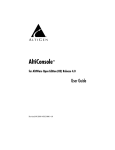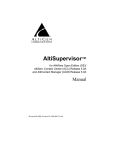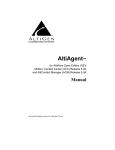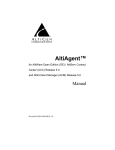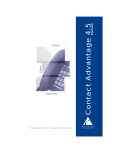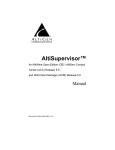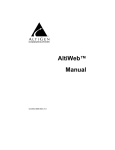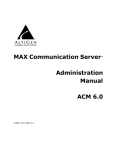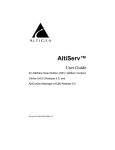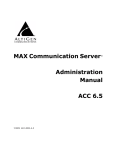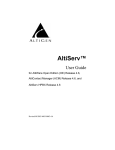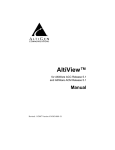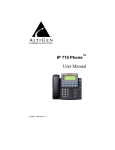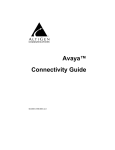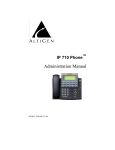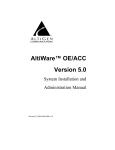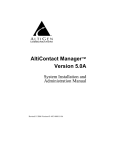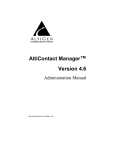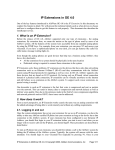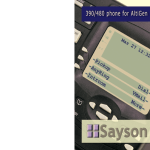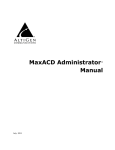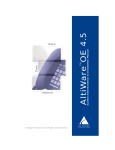Download Altigen Advanced Call RouterTM User guide
Transcript
CHAPTER 1 Overview With ACM, AltiGen has combined several separate compelling contact center productivity applications into one integrated system to handle daily voice, Internet, and email interactions. ACM is designed with an intuitive easy to use graphical user interface for your current IT staff to easily manage the system and reduce administrative costs. There is no need to learn complicated command line interfaces or manage disparate systems. Companies now can deploy a VoIP enabled contact center solution in days versus months. The basic AltiContact Manager software comprises: • AltiContact Manager Platform • ACM Software • 1 Agent seat • 1 AltiAgent Client session • 1 AltiView session • Industrial Chassis Intel 2.0 GHz Pentium IV • Centralized administration with easy-to-use GUI • Skills-based routing among 8 different call distribution choices • Priority queuing • An integrated IP or traditional PBX with voicemail for both extensions and voicemail AltiContact Manager Administration Manual 1-1 1. Overview AltiContact Manager™ is AltiGen’s new powerful turnkey, hardware/ software multi-channel IP Contact Center platform targeted at the formal small to midsize contact center market of 10-500 agents. The product is designed to provide contact centers with the essentials to service, respond and track performance of contact professionals. Since AltiContact Manager, or ACM, is IP-enabled and modular, call-centric businesses are protected against growing out of their investment. ACM software’s easy to use graphical user interface for business and contact center professionals is designed to increase overall productivity. • Unified Messaging integrating voice with E-Mail and third party fax, e-mail server • Easy to use IVR with capability to answer PSTN and Web calls • Enhanced ACD • Built-in CRM screen-pop with popular applications like Goldmine, ACT, Microsoft Outlook and Microsoft CRM • TAPI (Telephony API) Service Provider • Real-time status monitoring and reporting • Call Record to Voice Mail or to external server • Data synchronization with agent and supervisor desktop applications • Local and Remote IP agent and supervisor capability • Monitor and Barge in capable of advanced historical group and agent performance reporting options • Seamless integration with CRM, Advanced IVR, databases with easy to use SDK • Easy to plug in optional module to turn on web interactions for VoIP, chat, and Web page push. • Virtual Contact Center via VoIP • Callback Interview • Caller ID Routing • Configurable Emergency Number • Directory Name Announcement • Enhanced Call Forwarding • Group Call Distribution • Enhanced call routing by several categories • Huntgroups/Workgroups • Queue announcement • Queue quit option AltiContact Manager also includes the following IP PBX features: • Voice Mail 1-2 AltiContact Manager Administration Manual Overview • IVR • Line park • Group paging • Email Server • Configurable Emergency Number 1. Overview • Call Detail Reports (CDR) • Internet Integration • TAPI (Telephony API) Service Provider • Voice over IP • Digital T1/PRI/E1 Integration • Tie Trunks with Caller ID • Out Call Routing • Data Directed Routing • IP Extensions The AltiContact Manager computer telephony platform is built by installing one or more AltiGen boards into full-size ISA/PCI slots of a Windows 2000/2003 Server and then installing the associated AltiWare software. ACM Platform chassis and AltiGen Quantum and Triton boards may also be added and must be installed into PCI slots. See “System Limitations” on page 2-11 for details on the number of boards you can install on one system. Key AltiContact Manager Characteristics NEW • When you see this New icon, it means that the feature is new to AltiContact Manager Release 5.0A and does not exist in earlier versions. Quantum Board - a telephony card that uses DSP technology to provide trunks, lines, and voice processing resources. Quantum is an ISA compatible telephony card, which is designed around open software standards to facilitate implementation of thirdparty-provided applications in addition to the AltiContact Managerprovided applications. AltiContact Manager Administration Manual 1-3 Key AltiContact Manager Characteristics The Quantum telephony board has 12 analog ports, eight (8) of which are voice channels, so eight ports can listen to voicemail simultaneously. Additional Quantum boards can be added to meet larger system requirements. The maximum number of Quantum boards in one system is up to 16 boards and depends on the number of ISA slots available and the selected computer platform performance characteristics. Note: AltiContact Manager does not support Quantum Rev. C/C+ boards. Upgrade Quantum boards to Rev. D prior to installation. • Triton Boards: — Triton VoIP Board - a PCI bus telephony board that provides voice processing resources. DSP engines reside on the VoIP board to perform voice processing functions needed for H.323 devices. The Triton VoIP board supports 12 or 30 IP trunk ports. See “System Limitations” on page 2-11 for details on the number of Triton VoIP boards and ports you can install on one system. — Triton VoIP 12- and 30-port boards - Triton 8-port boards running on previous AltiWare releases are automatically upgraded to 12-port boards with AltiContact Manager. The 12-port board can be configured to a 30-port board in AltiContact Manager. • 5V PCI slot is required for each Triton board. • Additional VoIP boards, up to a maximum of ten (10) per system, can be added to meet larger system requirements. • The VoIP board can also be used individually as a third-party developer application platform. — Triton T1/E1/PRI Trunk Board - a PCI telephony card that supports either T1, E1 or PRI digital trunks through software configuration. • 5V PCI slot is required for each Triton board. • Additional T1/PRI boards can be added to meet larger system requirements. The maximum number of T1/PRI boards in one system is up to eight (8) T1/PRI lines (192 digital trunks). • Tone detection (fax, modem, voice) available. — Triton Analog Extension Board - a PCI bus telephony board that supports 12 analog extensions per board. 1-4 AltiContact Manager Administration Manual Overview • Provides adaptive balance and selectable impedance • Analog and digital loop back test modes • Tip and ring reversal • FSK message lamp • 5V PCI slot is required for each Triton Analog Extension Board. — Triton Analog Trunk Board - a long form factor PCI telephony card that supports 12 trunks, available in two models: loop start/ ground start (LS/GS) and loop start (LS). Both models have the same features regarding LS. The LS/GS board is required when ground start trunks may be required. You can install up to 16 Triton Analog Trunk boards per system. • Tone detection (fax, modem, voice) available. — Triton Resource Board - a PCI bus telephony board that provides monitoring and Barge In system support functions. You can install up to two (2) Resource Boards per system. • AltiContact Manager System Software - the system telephony application software that provides an easy-to-use graphical user interface. It lets you configure, administer, and maintain the AltiContact Manager system, and can be used as a platform for thirdparty enhanced application development. AltiWare software components such as Switching Service, Messaging Agent, SMTP Server, POP3 Server, AltiBackup and Exchange integration are services that are automatically launched when the AltiContact Manager system starts. You do not have to login and start these applications manually. This provides better security and reliability for these services. • TAPI Gateway Support - AltiContact Manager is an open platform that allows third party telephony developers to develop applications for the AltiContact Manager system. The system supports Telephony Applications Programming Interface (TAPI) 3.0. AltiContact Manager supports a complete TAPI service provider that accepts first party call control (such as AltiView, AltiAgent, and AltiSupervisor) and the third party client-server call control (such as call routing applications). AltiContact Manager Administration Manual 1-5 1. Overview • Recording capability Key AltiContact Manager Characteristics Call Center/IP PBX Features The Call Center/IP PBX features include telephone switching for making calls, answering calls, and transferring calls. For more sophisticated business applications, AltiContact Manager provides advanced features such as group call routing, multiple trunk and route access codes, scheduled call routing, and flexible call restrictions. For effective system management, AltiContact Manager provides information about system traffic and statistics to help the system administrator understand the dynamics of business communications and adjust resources such as the number of outside lines, accordingly. For more information on using PBX features, see the AltiServ User Guide or AltiView User Guide. In addition to station-to-station dialing, the PBX features include: Account Codes - allows the user to input an account code on each call to track telephone usage in order to bill back to clients or create a record of calls specific to a project and to budget and forecast expenses. Forced Account Codes force the user to input an account code on each call to track telephone usage. The administrator can configure which extensions are required to enter an account code. In ACM 5.0A, an option is added that allows the system to require an account code for long distance calls and international calls, but not local calls. NEW • Application Extension - a new type of extension that provides the interface to a third party product, such as IVR. • Busy or Ring No Answer Call Handling - sends calls to voice mail, another extension, or IVR if the called extension or group is busy or does not answer. • Callback Interview - caller will be prompted to enter a callback number and record a message. • Call Forwarding and Remote Call Forwarding - sends all calls to another extension, to a workgroup/huntgroup, to an application extension, or to an external telephone number. This allows users to redirect their calls to another location such as home or a branch office. Call Forwarding can be set up either at the source extension or at the destination extension on the system (Remote Call Forwarding). There is 10 hop limit on forwarded calls. 1-6 AltiContact Manager Administration Manual Overview Call Park and Pick Up - users can park calls at one station to be picked up at another station. Up to 50 calls may be parked at one station simultaneously. Calls parked to a group are protected. Only group agents or the person who parked the call can pick it up. • Call Park Ring Back Identification to Operator - when parked calls are not picked up, the operator will be rung, with call ID. • Call Restrictions - restricts users from dialing specific long distance area codes and phone numbers. Reduces the risk of toll fraud. Up to 20 digits are allowed to specify area codes and/or phone numbers that are restricted system-wide; up to 10 digits are allowed to specify area codes and/or phone numbers that are restricted on an extension by extension basis. Or, you may block ALL outgoing calls. • Caller ID - fully supports the Bellcore Caller ID standard and displays alpha and numeric caller ID and name on a standard analog telephone with a display. Up to 64 characters are transmitted and displayed. If your local exchange carrier provides enhanced caller ID, such as caller name, this information will also be displayed. • Caller ID Routing - the system administrator can define Caller IDs in a routing table and set different routing options. • Centrex Transfer - allows user to transfer or forward calls to an external telephone number. Once the transfer is complete, the trunk lines are released. AltiView and AltiAgent also support Centrex Transfer. • Conference Calling - the system supports conference calls with up to 6 parties. You can speak privately to each person before adding the person to the conference. A user can conference a call through an analog phone, IP phone, AltiView or AltiAgent. • Configurable Caller Name/DNIS Display - the system administrator can configure the Caller Name or DNIS displayed on a phone set. • Conversation Recording - an extension user (on Triton Analog Extension boards only) can record a conversation from a trunk and save as a file. Requires a voice recording license. • Dial Last Caller - allows user to dial the last caller. • Hands Free Mode - allows user to leave handset off-hook without having to hear the dial tone. AltiContact Manager Administration Manual 1-7 1. Overview • Key AltiContact Manager Characteristics • Direct Inward Dial (DID) - allows an incoming trunk call to directly access an extension without IVR intervention. Note: If your local exchange carrier provides DID service, DID calls will automatically be steered to the appropriate destination. • Directory Name Announcement - the huntgroup/workgroup agent’s directory name will be announced to the caller before the call rings to an agent. • Distinctive Call Waiting Tone - allows three different call waiting tone cadences to distinguish between internal, external, and operator calls. • Distinctive Ringing - allows three different ringing cadences to distinguish between internal, external, and operator calls. • Do Not Disturb - blocks all calls coming into a specific extension and sends them to preprogrammed destinations such as voice mail or the operator. • Extension Activity Display and Greeting - allows users to select from a set of pre-defined or customized activity codes that can be played or displayed when the user is absent. A greeting associated with the activity can be recorded and played to the caller. The activity is displayed if the caller is an AltiView, AltiAgent or Alti-IP 600 Phone user. NEW Extension Based Feature Profile - the system administrator is able to create an extension feature profile that includes enabling and disabling of extension features. • Feature Tips - plays helpful tips and reminders for optimal use of AltiContact Manager. • FSK-based Message Waiting - allows message waiting that is based on FSK (Frequency Shift Keying), a modulation technique for data transmission. Tone or voltage-based message waiting options can also be selected. Phones with FSK-based message waiting indicator are highly recommended. • Hands Free (Manual Answer) Mode - by pressing #82, allows an AltiView user to leave handset off-hook without having to hear the dial tone. All calls can be answered from an AltiView GUI. 1-8 AltiContact Manager Administration Manual Overview Hands Free Intercom Mode - by pressing #81 while on their speaker phone, users can receive internal calls without having to pickup the handset to answer. Hands Free Manual Answer Mode, #82, allows another version of this function. • Hop Off Calls over T1/PRI Tie Trunks - multiple AltiContact Manager systems at the same or remote locations can be linked through a T1/PRI network. Also, this feature provides toll savings on long distance calls by allowing users to dial a remote AltiContact Manager system via a T1/PRI trunk and then the destination phone number through PSTN. • Huntgroup - a group of related phones that can be set up to share particular lines, so that if the first line is busy, the next line is hunted until a free line is found. • Individual and System Call Pick Up - allows users to answer a ringing telephone from another station. • Intercom Call - by pressing #93 on any phone connected to an AltiWare system, users can make an intercom call to an AltiTouch 500 or Alti-IP phone (see note below). If the phone is in idle state, the phone speaker will be turned on, and the voice path is connected. If the IP phone is busy, the call will follow the busy call handling feature of the IP phone’s configuration. This feature can be enabled or disabled per extension by the administrator. Note: Alti-IP phones that are configured on a Triton Analog Extension board can be intercommed. • IP Extensions - the IP extension feature allows an H.323-compliant terminal device to connect to AltiContact Manager. With a few exceptions (described in Chapter 16, Setting Up IP Extensions), IP extensions have the same functionality as an analog station. • Line Park - allows for a set of 99 lines to be used as a park pool, where trunk incoming calls can be parked automatically, (by routing/call handling treatment in ACM Admin). Park Lines are organized into groups, with up to 99 groups supported. Parked calls can be picked up using #51. • Live Call Handling—allows an extension user to hear ringback tone when the called party is in voice mail, paging, transfer, or conference state. The call is shown as “ringing” in AltiConsole. AltiContact Manager Administration Manual 1-9 1. Overview • Key AltiContact Manager Characteristics Alti-Mobile Extensions—allows a regular CO connected PSTN phone, such as a home phone or cell phone, to be used to simulate a PBX office extension. The Alti-Mobile Extension has most of the PBX system’s call control and call center features. NEW • Multiple Call Waiting with Personalized Greetings - a personal queue that allows users to handle multiple incoming calls by letting callers wait in queue until the user answers the call. This allows users to transfer or park calls before answering the next call in queue. Users may also record and use personalized Initial and Subsequent greetings to be played for callers in queue. • Music or Message on Hold - when the system is connected to an external audio source, this allows callers to hear music or pre-recorded messages while waiting on hold. • One Number Access - a feature that eliminates “telephone tag” by forwarding important callers to predetermined numbers, according to a designated schedule. Setup is available through the One Number Access page of Extension Configuration and/or web-based AltiReach and AltiView management. ONA passwording is optional. The user can press any key to pick up an ONA call.ONA Call Screening allows a user to enable a call screening option to ONA, where a caller is prompted to record a caller name to continue ONA. • Operator Off-line - when this feature is enabled, all calls are directed to the IVR. When the caller dials 0 and the operator is not available, the call is routed to the operator mailbox. • Out Call Routing Configuration - allows outgoing calls to be directed to particular trunk routes, based on parameters assigned in AltiAdmin, and supporting the new tenant tables. • Outside Call Blocking - when this feature is enabled, access to outside lines is temporarily disallowed. • Overhead Paging - allows the use of voice paging over an internal public address system. • Overhead Paging by Trunk - allows the use of voice paging or broadcasting through a trunk without checking call progress. 1-10 AltiContact Manager Administration Manual Overview Personal Call Park and Pick Up - users can park calls at one station to be picked up at another station. Up to 50 calls may be parked at one station simultaneously. Calls parked to a group are protected. Only group agents or the person who parked the call can pick it up. If the user does not answer the call when it rings after the two-minute hold time, the call will be put on hold again. If the call is still on hold after two minutes, the system will ring the user again. • Power Failure Transfer - upon loss of power, this feature allows the first trunk and first extension on each Quantum board to be automatically connected. Ensures emergency outside line access in case of power failure. Press “0” Option for Extension in Voice Mail - allows a caller to press “0” while listening to an extension’s greeting. The “0” can be configured by the administrator to forward the user to voice mail, operator, or other destinations. NEW • Queue Announcement - before a call is send to a group queue, expected wait time and call position will be announced. • Queue Quit (Configurable Exit Queue) - a caller can press “#” or “0” to leave a workgroup queue to transfer to group voice mail, IVR, extension, another group, or an operator. • Return to IVR - after leaving a voicemail message and pressing # to send it, incoming trunk callers are prompted with the option to return to IVR to try another path or person. • Single Call Waiting - allows users to put an existing call on soft hold and take a second call upon hearing a Call Waiting tone. The user can then alternate between the two calls. • Station Log In/Log Out - enables system users to move an extension number from one station to another, or deactivate an extension on a long-term basis. • System and Station Speed Dial - allows programming of frequently used telephone numbers for speed dialing. Up to 60 system speed numbers can be programmed. Up to 20 station speed numbers can be programmed for each extension. For easy programming, AltiWare uses friendly voice prompts to guide extension users to program their station speed dial numbers. AltiContact Manager Administration Manual 1-11 1. Overview • Key AltiContact Manager Characteristics • System Callback from IVR - allows the user to instruct AltiContact Manager to call the user at a remote location after the user logs in with extension and password. This is useful for traveling users who don’t want to accrue expensive toll charges while traveling, especially from international locations where there is no access to toll-free numbers. See “Planning is Essential” on page 11-1 for more information. • Transfer to AltiGen Voice Mail System - allows anyone in the office to send an outside user into the AltiGen Voice Mail System by pressing FLASH # 40 while connected to the user. • Transfer to IVR - allows a user to transfer a call to an IVR by pressing FLASH #15 and then the 2- or 3-digit IVR number. • Trunk Digits Pushed to AltiLink Plus - Digit event will be sent through AltiLink Plus (SDK) when the caller presses any key during IVR. • Trunk Interface: — Analog - loop start, ground start, and wink start (DID). — Digital - PRI-ISDN, T1 E & M, loop start, and ground start. • Virtual Extensions - an extension that is not associated with a physical port, but allows access to the AltiGen Voice Mail System features and telephone sharing. Up to 2,000 total (physical + virtual) extensions can be created on a system. Access to virtual extensions is through voicemail use, a physical extension, a trunk, or via AltiView or AltiAgent. • Workgroup Call Pickup - allows pickup of calls to a specific group. • Flexible Wrapup Times and Inter Call Delays - can be used to set delays before the system sends the next call to an extension. Further, the user can manually set the extension state to Ready or Not Ready to receive calls. Automatic Call Distribution Features Automatic Call Distribution (ACD) features include: • Advanced Queue Management Application (AQM) - enables advanced queuing options: — one level IVR menu selection from queue 1-12 AltiContact Manager Administration Manual Overview — advanced queue overflow for configuration of overflow conditions and actions After Hours Handling for Workgroups - a workgroup can be assigned a Business Hours Profile through ACM Admin. Also, after hours routing decisions can be configured for each day of the week. When a call is forwarded to this workgroup after hours, the call is routed automatically, based on the routing decision for that day of the week. • Agent Set to Not Ready When RNA - when a workgroup call rings an agent and is not answered, this feature automatically sets the agent state to Not Ready for all the workgroups the agent is currently logged in to. • Auto Logout - a group member can be automatically logged out if a call is not answered. • Business Hours - allows for setting morning and afternoon business hours for each day of the week. Multiple business hours can be configured in a system. Also, multiple Business Hours profiles can be assigned to DNIS Routing and Trunk In Call Routing entries. • CDR Search - allows workgroup supervisors to search CDR files and workgroup CDR statistics for records that match selected criteria. CDR Search provides workgroup statistics from the real-time monitoring function used in the AltiSupervisor client application. Settings in ACM Administrator let you specify time intervals for saving RTM data. • Call Queuing - places caller in a queue to wait until an ACD group member becomes available. • Call Queue Announcement - before a call enters a workgroup queue, the system announces the expected wait time or call queue length to the caller. • Call to Queue Alert - agents can be alerted via a beep and a screenpop when a call enters the workgroup queue. • Configurable Call Wrapup Time - allows a group member some time in between calls to wrap up on notes, prepare for the next call, or logout of the group. This wrapup time is configurable on a per-member basis. AltiContact Manager Administration Manual 1-13 1. Overview • Key AltiContact Manager Characteristics •Dialed Digit Translation - allows the administrator to select a single dialed digit that can be assigned to route a call to any destination. First Digit Translator allows the administrator to select a single dialed digit that can be assigned to route a call to any destination. Extension Dialed Digit Translator allows predefined dialed digits by an extension to be translated into a different dialing string. In ACM 5.0A, a digit manipulation option allows you to remove or add digits to a number dialed by the IP extension. An extension can also have multiple dialing digit patterns. NEW • Distinctive Ringing for Workgroup Calls - allows workgroup incoming calls to use a different ringing cadence from normal calls. • Holiday Routing - routes inbound DNIS and trunk calls on designated holidays to specified destinations. You can create separate routes for business and non-business hours on half-day holidays. Multiple Holiday Profiles can be configured in a system. Also, multiple Holiday Profiles can be assigned to DNIS Routing, Caller ID and Trunk In Call Routing entries. • Login/Logout/Keep Login Status on system startup or reboot - all group members can be set to the “Login” or “Logout” state at system startup or reboot. By default, group members are set to “Keep Login Status.” • Multiple Queue Announcements - allows each group to have its own set of unique audio announcements. Up to five announcements can be configured for each group. The intervals between announcements can also be configured. • Multiple Workgroup Membership - allows each extension to belong to multiple groups. The system can be configured with a maximum of 64 groups (workgroup/huntgroups/paging groups). • Multiple Workgroup Log In and Log Out - lets group members quickly log in and out of multiple groups. • Outbound Workgroup Call Monitoring - Workgroup supervisor can monitor agent’s inbound and outbound calls. If an agent wants to make a personal call that is not monitored, the agent must either log out or set the Outbound Workgroup to N/A (if enabled in AltiAdmin). Calls can be barged-in on regardless of login status. 1-14 AltiContact Manager Administration Manual Overview Picking/Transferring Calls from Group Queue - enables an extension to pick any call in queue using AltiAgent or AltiConsole. AltiSupervisor is also able to transfer a workgroup queued call to any extension, workgroup, IVR, voicemail or outside number. • Priority Queuing - allows for calls in queue to be associated with priority. The call priority can be assigned though Caller ID routing, DNIS routing, IVR, Advanced Call Router or API in AltiGen SDK. • Ready/Not Ready - members can also enable a “ready” (#90) or “not ready” (#91) status to inform the system whether or not the agent is able to receive the next call. • Real Time Monitoring — Real Time Display for AltiAgent, AltiSupervisor and SDK is restructured to separate inbound and outbound call statistics. — IP Multicast is implemented to deliver real time data to client applications. — Agent states are redefined and time in each state is tracked. • Service Level Threshold - a time value for callers waiting in queues. The performance statistics show when workgroup calls are queued for longer than a prescribed value. • Single/Multiple Call Handling for Workgroups - allows the workgroup administrator to select single or multiple calls handling operation for workgroup agents when holding a workgroup call. • Skill-Based Call Distribution - the system administrator can define different skill workgroups and then assign different skill levels for agents for incoming calls, which will ring the lowest member agent first, from 1 to 9. Levels 1 to 9 can also be described as proficiency for a skill group for an agent. • Workgroup CDR/RTM — the CDR/RTM database is updated with additional data fields. — CDR Logger Service uses standard ODBC interface and SQL2 to interface with the CDR database. Certified third party databases compliant with ODBC can be supported as well. — One External Logger Service can run on the system, while Internal Logger Service is running. Also, a configurable Authentication String between external loggers and the system is added to allow extra security. AltiContact Manager Administration Manual 1-15 1. Overview • Key AltiContact Manager Characteristics • Workgroup Call Routing - for special call handling applications, incoming calls can be routed to a group. For automatic distribution, calls can be distributed to the first available group member, or among group members according to the following options: — Ring First Available Member — Ring Next Available Member — Ring All Available Members — Ring Longest Idle Member — Ring Average Longest Idle Member — Ring Fewest Answered Calls — Ring Shortest Average Talk Time — Skill-Based Routing When all the members in a workgroup are busy, calls can be overflowed to another workgroup or extension, directed to the workgroup voice mail, to workgroup members voice mail, or placed in the call queue for the next available member. When the first called member fails to answer the call within the number of rings configured, the system can direct the call to the next available workgroup member. The system can also ring the longest idle member or ring all available members. Calls encountering RNA among all agents can be automatically directed to an alternate destination. • Workgroup Logout Reason Codes - allows a workgroup member to enter a reason code when signing off. Up to 20 reason codes may be defined. • Workgroup Member (Agent) Login/Logout - allows huntgroup/ workgroup members to log in and out of a group so that incoming calls bypass the workgroup member (agent) who has logged out and the call is automatically routed to other active group members or ACD agents. This feature is available only to group members and is disabled through group configuration. Logout does not block direct calls to the group member’s extension. • Workgroup Membership - groups can have up to 128 members. 1-16 AltiContact Manager Administration Manual Overview Workgroup Monitoring - allows real-time monitoring of workgroup information—trunk state, group status, call queue status, details of group queue entries and agent status. Limited monitoring is available through a group view window in ACM Admin or remotely through AltiReach. Caller ID identifies agent calls as inbound or outbound, internal or external. • Workgroup Silent Monitoring - with the Triton Resource Board, allows a workgroup supervisor to silently monitor calls between workgroup agents and callers. Personal calls can also be silently monitored by a workgroup supervisor. • Workgroup Barge In - with the Triton Resource Board, allows a workgroup supervisor to barge into calls between workgroup agents and callers. The supervisor can barge in on a specific agent by entering the agent’s extension via the telephone. Calls can be monitored regardless of login status. Personal calls can also be barged in on by a workgroup supervisor. • Workgroup Queue Overflow Handling - routes incoming calls to an alternate destination when the queue is already full, or when incoming calls will have an unacceptably long wait time. IVR Features The IVR features provide quick and courteous processing of all incoming calls. An IVR can be configured to serve as a primary Attendant or as a backup to a receptionist. IVR features include: • Call Priority- allows the workgroup administrator to assign a priority level to an IVR attendant. • Dial By Name - allows a caller who does not know your extension number to spell your name using the telephone key pad. The system will search the Directory and make a match on the name to connect the caller to the intended party’s extension. The caller can match first OR last name when dialing by name. • Data-Directed Routing - allows the routing of calls directed by the caller’s input (digit or text). Third party applications can be used to route incoming calls based on caller information. • Digit Collection - caller can be prompted to enter numbers, which are then collected and used for routing the call. AltiContact Manager Administration Manual 1-17 1. Overview • Key AltiContact Manager Characteristics • Direct Station Transfer - allows the IVR to handle all incoming calls instead of being answered by an operator. Callers can dial an extension number to reach a specific station or use the name directory to find an extension number. • Failover Routing - allows the IVR to provide a new menu path as a failover action if the Collect Digits action fails. • Multiple IVR Support - allows up to 255 editable IVR attendants. • Name Directory Service - allows callers to hear a list of employees and their extension numbers. • Nine-level Programmable Menus - allows multiple levels of recorded menu options for specific routing of calls. • Programmable Time-Out Handling - allows the administrator to select the action the system should take if there is no digit detected by the caller within specified seconds. • Schedule-Based Call Processing - routes calls differently for different times of the day. • Web-based Call Processing - allows the IVR to accept calls placed over the World Wide Web. AltiGen Voice Mail Features The AltiGen Voice Mail System is a sophisticated message management system that provides the calling and the called parties with enhanced communication features. It allows greater accessibility, faster reply time between parties, and reduces the frustration of telephone tag. The AltiGen Voice Mail System is described in the AltiServ User Guide. A summary of voice messaging features include the following: • AltiGen Voice Mail Access from Voice Mail Greeting - users can log into the AltiGen Voice Mail System by pressing * during the voice mail greeting of any extension. • AltiGen Voice Mail Quick Features - allows direct access to a specific AltiGen Voice Mail menu without having to login to AltiGen Voice Mail System. 1-18 AltiContact Manager Administration Manual Overview Call Forwarding from Voice Mail - users can set up Call Forwarding from within the AltiGen Voice Mail System. This allows users to set up Call Forwarding away from the office and without having to access AltiReach or AltiView. • Disable a Mailbox - voice mailboxes can be disabled so that callers cannot leave messages. This can be useful for maximizing system capacity or controlling access to phone services. • Configurable voicemail playing order - Administrators can configure users’ voice mailboxes to play the oldest or the newest message first. • Future Delivery - allows users to record a message to be delivered at a specific time and date in the future, up to one year in advance. • Information Only Mailbox - a mailbox can be configured to announce customized pre-recorded information when accessed. This mailbox does not allow callers to leave a message, but only to listen to the message announcement (personal greeting) from the mailbox. To repeat the message, callers are instructed to press the # key. • Making a Call from the AltiGen Voice Mail System - allows users to make a call from within the AltiGen Voice Mail System by pressing # at the Main Menu and entering the external phone number. This is especially useful while traveling where users can respond to all messages and make other calls not associated with a message, all with one call into the AltiGen Voice Mail System. This can result in significant savings. The use of this privilege is configurable on a peruser basis. • Message Management - receives, sends, forwards, deletes, and replies to messages. • Message Notification of E-mail Messages - designed to alert you of new voice and/or email messages in your mail box. (At this time, notification of email messages can only be configured by the system administrator.) The AltiGen Voice Mail System will notify you by calling an extension, phone or pager number. A notification schedule can be set for business hours, after business hours, at any time or at a specified time. For voice messages, you have an option of being notified of all messages or only urgent messages. You may enter up to 63 digits for the destination (notification) phone number. Operatorassisted paging is also supported. AltiContact Manager Administration Manual 1-19 1. Overview • Key AltiContact Manager Characteristics • Personal/Activity Greeting - allows users to record personal and/or activity greetings in their own voice to be played when callers reach their voice mail. • Priority Delivery - allows users to determine the priority of message delivery such as normal or urgent. • Private Messaging - allows users to leave a private message in their voice mail for the expected caller. • Record Conversation to Voice Mail - an extension user (on Triton Analog Extension boards only) can record a conversation and save as a voice mail. Requires a voice recording license. • Reminder Calls - are used to remind you of important meetings, things to do or people to call. • Remote Access - allows users to access the AltiGen Voice Mail System from any telephone by dialing into the main system number and pressing # to login. • Voice Mail Distribution List - allows the user to use system distribution lists, or create and use personal distribution lists for forwarding voice mail. Up to 100 distribution lists can be created. Each distribution list can have up to 64 entries, and any entry can be another distribution list. • Zoomerang - allows users to listen to messages in the AltiGen Voice Mail System, prompt the system to automatically call the party who left the message, and then return to the AltiGen Voice Mail System to continue checking messages, all in a single call into the AltiGen Voice Mail System. If the caller ID information is not captured, the user may enter the “call back” number manually. Internet Integration Features Internet integration features include: • 1-20 AltiReach™ - a Web-based management tool that provides a way for users to visually manage their call handling options such as OneNumber-Access, CallView, Message Notification, Speed Dial Numbers and other personal phone settings using a standard Web browser. Groups can also be monitored and configured over AltiReach. AltiReach is further described in the AltiServ User Guide. AltiContact Manager Administration Manual Overview Built-in E-mail Server - a complete SMTP/POP3 email server is built into the AltiContact Manager system so that all you need is an SMTP/ POP3 email client to send and retrieve Internet email. The system allows use of alpha character-based passwords. • CallViewTM - a Web-based Java application that allows for call control using a standard Web browser to manage multiple incoming calls and view information including Caller ID, calls in queue and extension status. • Exchange Integration - provides unified messaging between AltiContact Manager and a Microsoft Exchange server on the LAN. The state of both servers will be synchronized. This feature allows for dynamic synchronization of mail between the two servers so that deleted messages from one server get automatically deleted in the other server. Similarly, a new message sent to one server is transmitted to the other server. This way, the message can be accessed or deleted from either server. For example, when a voice mail is deleted from AltiContact Manager, it is automatically deleted from the Exchange server too. The address of the Exchange server must be the name of the machine or the fully qualified domain name. • Mail Forwarding - allows you to forward mail (email and voice mail) to an SMTP-based mail server. The destination server address should be the address of the SMTP server to which all mails should be forwarded. This address can be an IP address such as 100.200.101.201, a domain name such as altigen.com, a fully qualified domain name such as symphony.altigen.com or a machine name such as symphony. • Mixed-Media Messaging - allows users to combine multiple forms of communication (such as voice mail, email, data file, etc.) into a single e-mail message. The user can record a voice message using a telephone handset or microphone on a multi-media PC and attach it to the AltiGen Voice Mail System for delivery to an internal user (LAN) or an external user (internet) who can listen to it from the PC. The recipients of the AltiContact Manager system also have the option of listening to annotated messages from the handset. • Remote Download of Messages via Internet - allows users who are traveling and/or working at home to download all new voice and email messages in their the AltiGen Voice Mail System Post Office Box via a local internet access line. • Support of Internet E-mail Standards - allows the user to send and retrieve email using any SMTP/POP3 e-mail client. AltiContact Manager Administration Manual 1-21 1. Overview • Key AltiContact Manager Characteristics System Administration Features System Administration features include: • Access Restriction - allows administrators control over system user access to features and trunks. • ACM Remote Administration - a version of the AltiContact Manager Administrator application that can be installed on a Windows 2000 or Windows 2003 client computer installed and used on the LAN to remotely administer one or more AltiContact Manager systems. If there is no firewall on the LAN where AltiContact Manager resides, ACM Administrator can be installed and used to manage AltiContact Manager over the Internet from a remote site as well. This also allows the ACM Administrator on the AltiContact Manager to be closed without affecting the telephony functions that continue to run in the background on the server. • Apply To Feature - applies changes (only the field that was changed) to multiple extensions, trunks or channels instead of having to change them one at a time. • Call Detail Reporting (CDR) - the system collects and records information on outgoing and incoming phone calls, such as length of call, time of call, number of calls. This data can be written to an internal database or to an external SQL database. CDR Search provides an interface that captures workgroup statistics from the realtime monitoring function used in the AltiSupervisor client application. Settings in ACM Administrator let you specify time intervals for saving RTM data. • Configurable Emergency Number - For international use, allows the system administrator to set up country-specific emergency numbers. • Configuration Reader - a tool that summarizes details of your AltiContact Manager configuration, so you can send a single file to AltiGen Tech Support if needed. • DNIS Routing Tables - incoming trunk calls can be routed to trunks to IVR, extensions, huntgroups, etc., based on DNIS digit information configured in system administration routing tables. • E-911 Calling Support - allows an administrator to designate a number of trunks (Quantum Analog, Triton Analog, or PRI) for dedicated E-911 use. CAMA trunks are supported by Quantum analog and Triton analog trunks. 1-22 AltiContact Manager Administration Manual Overview • Email and Voice Mail Storage - can be placed on drives other than the AltiContact Manager server. Emergency (911) Call Notification to Extension/Outside Number - when any extension dials an emergency number, the system can make calls to pre-configured extensions or outside numbers. A system can have more than one emergency number configured. NEW Enhanced Password Security - allows administrators to lock extensions that have been “attacked” with false password attempts and to set default system passwords for newly created or newly assigned extensions (more secure than the default of an exact extension/ password match). Password requirements are also stricter. • Extension Calling Number Support - each extension can be configured with a calling number. When an outgoing call is made by this extension through PRI or IP trunks, the calling number will be displayed as the Caller ID to the receiving caller. • Extension Checker - a tool that checks the security status of every extension in your AltiContact Manager system. • Extension Password Protection for Application Logins - the system maintains a counter for each extension to track AltiLink Plus login failures. When eight (8) successive failures are reached, the system disables AltiLink Plus for 1 to 24 hours to prevent password intrusion. Applies to login from AltiView, AltiAgent, AltiSupervisor, AltiConsole, CDR Search, Advanced Call Router and 3rd party applications base on AltiGen SDK. • IVR Configuration File - lets you export your complete IVR configuration to an html file. • Monitor List - lets you select the Physical or IP extensions you wish to monitor. Monitoring is available within AltiView and AltiSupervisor. • Out Call Routing Configuration - allows outgoing calls to be directed to particular trunk routes, based on parameters assigned in ACM Administrator. • Queue Management APIs - enables third party queue management applications to interact with AltiContact Manager for control of queuing properties. AltiContact Manager Administration Manual 1-23 1. Overview • Key AltiContact Manager Characteristics Redundancy - system redundancy feature that requires two systems, a primary and secondary; the primary system is in control of all operations, which the secondary server keeps a connection with the primary server. When the primary server goes down, the secondary server takes control. NEW Important: Dataprobe A/B Switch is required to switch trunk and extension wiring to the secondary system when primary system goes down. Redundancy Call Notification to Extension/Outside Number - when a system switches over through the Redundancy feature, the system can be configured to make a call to a pre-configured extension or outside number. NEW • RTM External Logger - RTM data is sent to the External Logger. • Scheduled Agent Auto Logout - allows an administrator to automatically logout all workgroup agents based on up to three (3) scheduled times. • Split Area Code Support - allows you to identify area codes and prefixes that are exceptions to the standards of how area codes and long distance prefixes are normally used. For example, this configuration allows the system to treat calls to certain areas as local calls. • Third Party Queue Management Application Support - enables third party queue management applications to interact with AltiContact Manager to replace built-in ACD queuing functions. This allows the flexibility of offering queue customization or extending queuing function through external applications. • Trunk Recording - recording is supported for Triton Analog, T1/E1 and IP trunks, and can be automatically activated by AltiContact Manager or by SDK-based applications for incoming and/or outgoing calls. • Voice Mail Distribution List - allows you to create a group of extensions for forwarding voice mail. Up to 100 distribution lists can be created. Each distribution list can have up to 64 entries, and each entry can be another distribution list. • Voice Mail Alert - An announcement can be sent to Voice Mail when the email server disk is full. 1-24 AltiContact Manager Administration Manual Overview • Work/Hunt Group Converter - used when upgrading from AltiWare OE 4.6, this tool that converts agents to non-agents, non-agents to agents, workgroups to huntgroups and huntgroups to workgroups. T1/PRI/E1 Features T1/PRI features include: ANI/DNIS Transport over T1/PRI Tie Trunks - ANI (Automatic Number Identification) and DNIS (Dialed Number Identification Service) digits for calls can be forwarded and transmitted between extensions at remote AltiContact Manager systems. • Collecting Caller ID/DID Digits for T1 - allows you to configure the format and sequence of caller ID and DID digits using DTMF for a T1 connection. • Collecting Caller Name for PRI - PRI Caller Name feature is incorporated, compliant to NI-2 standard. • Support for E1/PRI Voice over IP Features Voice over IP features include: NEW #27 Station Login Behavior Change - in 5.0A, a user will be able to override any extension phone by pressing #27. • ACM Administrator Remote Administration - remote AltiContact Manager locations can be managed using ACM Administrator. • AltiContact Manager-to-AltiContact Manager Networking Capability - multiple AltiContact Manager systems at the same or remote locations can be linked through an IP network. Also, this feature provides toll savings on long distance calls by allowing users to dial a remote AltiContact Manager system via an IP trunk and then the destination phone number through PSTN. • AltiContact Manager Feature Support - many of the AltiContact Manager features are also available when using IP trunks. See “Voice over IP Session Support AltiContact Manager Features” on page 1-28 • Board ID Support - The board ID of the Triton IP board is displayed in the ACM Administrator board window. This can be used to relate a Triton VoIP board to a hardware board. AltiContact Manager Administration Manual 1-25 1. Overview • Key AltiContact Manager Characteristics • DNIS Name Display and Routing over IP Tie Trunk - allows for DNIS information to be transferred to the system when routed over IP tie-trunks. DNIS name of matched entry is displayed at AltiConsole, AltiView, AltiAgent and handset. • DTMF Remote Carriage - DTMF tones and/or digits are detected and sent out-of-band, over a reliable TCP/IP channel to the remote AltiContact Manager, to guarantee the delivery. • Dialing Prefix Filter - users may select a PSTN or IP trunk when making outgoing calls by dialing a configurable access code. • Echo Cancellation - due to bandwidth limitations and device loading, long delays may occur during packet delivery process, which worsens the echo effect of recorded and live voice speech. Echo cancellation is provided to maintain reasonable voice quality. • G.711 Codec - toll quality (64K) digital voice encoding, which guarantees interoperability for better voice quality. • G.723.1 Codec - a dual rate audio encoding standard, which provides near toll quality performance under clean channel conditions. VAD (Voice Activity Detection) capability is also included to suppress silence packets. • G.729 A+B Codec - speech data encoding/decoding standard of 8 Kbps; the encoder functionality includes VAD, the decoder functionality is capable of accepting silence frames and generating comfort noise (CNG). • H.323 Standard Support - AltiWare IP is based on the H.323 protocol, which is an emerging ITU standard for multimedia communications over IP. • IP Extensions - the IP Extension feature allows an H.323 compliant terminal device to connect to AltiContact Manager. IP extensions have the same functionality as an analog station. Group agents can log in from a remote location using IP extensions. IP Extension Auto Failover - when an IP extension is unreachable, the system will automatically fail over to a configured physical extension, which includes Alti-Mobile Extensions and office extensions. NEW 1-26 AltiContact Manager Administration Manual Overview IP Phone Service - a service that runs on the same system as AltiContact Manager, is installed together with AltiContact Manager, and connects to AltiContact Manager through enhanced AltiLink Plus protocol on behalf of AltiGen IP Phones. • IP Port Support - AltiContact Manager IP port density is increased to 120 ports. The system supports up to ten (10) Triton IP boards (120 ports) or, two (2) G.723 and two (2) G.711 (84 ports). • Integrated Administration - calls through both PSTN and IP networks can be managed using a single point of administration. • Integrated VoIP Gateway - because the VoIP gateway is built-in to the system, translation of PSTN calls to IP calls and IP to PSTN calls are smoother and more successful. Also, the Overlap dialing is enabled and the dialing sequence is smoother for end users. Without the need for cable configuration and the purchase of additional analog ports, there can be significant time and cost savings. • Jitter Removals - due to various delays in the IP network, audio packet streams may be delivered late or out of order. AltiContact Manager is able to buffer incoming packets and re-sequence them by maintaining a queue. This queue is adjustable to accommodate different network environment characteristics. • PCM-based Music File - A pre-recorded music on hold file (AltiGen PCM format) for IP ports can be played. • IP Group Paging - allows the use of group voice paging to Alti-IP 600 phone users in a group. • Release Link Tie - when transferring between two systems through IP tie trunks, the trunks can be released by pressing FLASH *. • Ring-Back Tone Generation - ring back tones can be generated to other analog trunk or extension lines on behalf of the IP trunk. • Silence Detection and Suppression - A silence detection feature enables the following: — Silence Suppression - when silence suppression is enabled and silence is detected, AltiContact Manager stops sending packets to the other side. The other side does not receive any packets and plays silence. AltiContact Manager Administration Manual 1-27 1. Overview • Key AltiContact Manager Characteristics — AltiContact Manager disconnects the voice mail session when a silence period exceeds 7 seconds during voice mail recording over VoIP. • VoIP Hop Off Call Support - allows an extension to access a T1 or CO trunk on the remote system and “hop off’ to dial an outside telephone number. This “hop off’ feature can be enabled or disabled on the remote system. Outcall restrictions for hop off calls are configurable. Voice over IP Session Support AltiContact Manager Features The following trunk-related AltiContact Manager features are supported during IP trunk call sessions. Refer to the AltiServ User Guide for more details on how these features work over IP trunks. • Incoming and Outgoing Trunk Calls • Call Transfer To and From IP Trunk (Blind & Supervised) • One Number Access • Message Notification • Reminder Calls • Multi-Location Conferencing • Call Park • Call Waiting • Call Forwarding • Automatic Call Distribution • IVR • System Call Back • Calling Out from Voice Mail • Zoomerang • Dial Last Caller • Speed Dialing • Call Accounting • Caller ID • Voice Mail • MS Exchange Integration • AltiConsole Client Support 1-28 AltiContact Manager Administration Manual Overview • AltiReach Support • AltiView/AltiView IP Extensions • Intercom • IP Extension Log In/Log Out • Conversation recording 1. Overview • Trunk recording AltiWare Applications AltiWare comes with useful applications for testing, diagnosing and operating your AltiContact Manager configuration. • AltiVR Player - voice recording playback tool that can be used by the administrator to access all voice recording data in a centralized location. • CT-bus Test Tool - detects one-way connection, cross talk, bad MVIP cable, and static noise problems. • DINA Manager - an application that allows a system administrator to configure several distributed systems from a single system. The tool can be run on any server (local or remote) to an AltiContact Manager system that has a connection for access to all the servers to be managed. DINA Manager can support multiple versions of AltiWare and AltiContact Manager. Also, extensions across multiple systems can be deleted. • Extension Phrases Replicator - allows you to synchronize extension phrases in a multi-system environment. The tool will manually or automatically synchronize all extensions’ names and greeting phrases between all AltiWare servers specified in EPR. Once installed, EPR runs using a new service — AltiGen Extension Phrases Replication Service — to connect to each system. • AltiPCM - a program to convert PCM wav file to AltiGen’s PCMbased phrases or music on hold files. AltiContact Manager Administration Manual 1-29 Key AltiContact Manager Characteristics Optional Add-On Software • AltiConsole™ - a personal, computer-based Attendant console connected to AltiContact Manager over a network; emulates a standard, hardware-based Attendant console through software; has the flexibility of adding new features through software without changing the hardware. In ACM 5.0A, the following enhancements have been made: — Display workgroup name instead of workgroup number is the Workgroup window — Configuration field added in the Overhead Paging configuration for station paging connect to an analog extension port — Auto Answer feature added • AltiView/AltiView IP Extension - a Windows-based desktop call control and window popup application that interacts with AltiContact Manager through AltiLink Plus and provides easy-to-use call control, monitoring and logging capability. In ACM 5.0A, the following enhancements have been made: — Support for IP Talk — Mute button — Add workgroup name field in Monitor window — Add extension activity field in Monitor window — Setting Activity made easier — Inputted number kept when switching between Voice Mail and Calls tab — Reconnect button when AltiView connection is dropped — Changed auto answer minimum duration to 0 seconds • AltiAgent™ - a workgroup user version of AltiView; in addition to AltiView features, also provides call statistics, call wrap up with data entries, logon/logoff with reason codes and agent ready/not ready status. In ACM 5.0A, the following enhancements have been made: — refer to AltiView 5.0A features list • 1-30 AltiSupervisor™ - provides workgroup statistics, silent monitoring and barge-in features. In ACM 5.0A, the following enhancements have been made: AltiContact Manager Administration Manual Overview — Color coded priority in queue — Force agent phone to virtual (unstaffed), applies to physical extension only — Change Transfer button to Redirect button Indicator for recorded agent conversation • Alti-MSCRM - a Microsoft® .NET-connected integration tool that provides CTI integration, including screen pop capability, for Microsoft CRM. In Alti-MSCRM 2.0, the following enhancements have been made: — Answering script for workgroup agents — Search and dial buttons — Call logging — Data loading performance optimization NEW • AltiReport - allows administrators to generate call center reports for ACC/ACM 5.0A. CallRouter - a call handling application that uses ACM Administrator Auto IVR and AltiAPI Data Directed Routing features to match incoming trunk call data against customer records built using the Call Router GUI. The Call Router Advanced license gives additional features including dynamic searching of DNS data to match against incoming call data, and workgroup call queue announcements. In ACM 5.0A, the following enhancement has been made: — Setting call priority for Advanced Call Router • CDR Search - allows administrators to search CDR files for records that meet selected criteria, and allows workgroup supervisors to search both CDR files and workgroup CDR statistics. In ACM 5.0, the following enhancements have been made: — Workgroup CDR restructuring — CDR Search Tool for 4.6 CDR database — Dual external CDR database support SuperQ - a Java-based application designed to queue and distribute calls for call centers with workgroups located in different geographic locations or across multiple AltiGen servers. SuperQ enables call centers to combine teams of workgroups from multiple locations into one virtual team. NEW AltiContact Manager Administration Manual 1-31 1. Overview • Key AltiContact Manager Characteristics NEW VRManager - allows administrators/supervisors to convert, schedule backup/delete, and query recorded files. Optional Add-On Products • Alti-IP 600 - AltiGen’s H.323-compliant, business telephone that provides voice communication over an IP network. In ACM 5.0A, the following enhancements have been made: — Time zone offset — Time format display — Extension speed dial directory Optional Kits • SDK 2.8.1 Tool Kit - offers a complete set of tools including APIs, documentation and sample programs, to enable a developer to begin programming rapidly and efficiently. It includes a self-installing CDROM containing AltiGen SDK software. Session-based licensing is required for both Basic API and APC API interfaces. In AltiGen SDK 2.8, the following enhancements have been made: — Queue Management APIs — Extension relocation — AltiView/AltiAgent ActiveX MakeCall API 1-32 AltiContact Manager Administration Manual
































